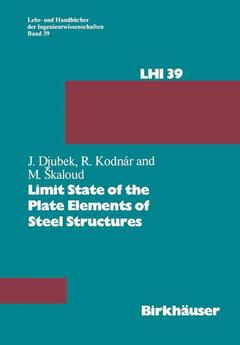Limit State of the Plate Elements of Steel Structures, 1983 Lehr- und Handbücher der Ingenieurwissenschaften Series, Vol. 39
Langue : Anglais
Auteurs : Djubek J., Kodnar , Skaloud

The necessity to save steel leads to a marked tendency towards thin-walled structures. Such structures are made of thin plating, the behaviour - and, of course, design - of which is very significantly affected by stability phenomena. In fact, with up-to-date thin-walled steel plated structures, it is very frequently the point of view of stability that governs the design. So it is not astonishing that the attention of a great number of research teams in various parts of the world has been for a good many years directed to investigations into numerous aspects of the buckling behaviour of steel plated structures. However, the current problems of buckling research, which require to account for the effect of initial imperfections, post-buckled behaviour and plastic reserve of strength (this leading in theoretical research to the necessity to solve boundary value problems of geometrically and physically non-linear partial differential equations, and in experimental studies to conduct experiments on full-size test girders) are very complex and time-consuming. Then it is beyond the means of one investigator, or even of one research team, to deal successfully with such problems and, conse quently, effective cooperation is indispensable. This was also the reason for the initiation of a fruitful collaboration between the first author of this book (Assoc. Prof. J. Djubek, D. Sc. ) and the third author (Assoc. Prof. M. Skaloud, D. Sc.
1 Basic Assumptions of Theory of Slender Webs.- 1.1 Basic Notions and Formulation of Basic Assumptions.- 1.2 Relationships between Web Deformations and Displacements in Its Middle Plane.- 1.3 Relationships between Deformations and Stresses.- References.- 2 Mathematical Problems of the Fundamental Equations.- 2.1 Introductory Remarks.- 2.2 Some Types of Equations from Considerations about the Flexure of Plates.- 2.3 Basic Boundary Value Problems.- References.- 3 Approximate Methods of Solution.- 3.1 Compactness Method.- 3.2 Topological Method.- 3.3 Variational Methods.- 3.4 Uniqueness of Solution.- 3.5 Two-Sided Estimations of Approximate Solutions.- References.- 4 Bifurcation Problems of Basic Equations.- 4.1 Properties of the Homogeneous Problem.- 4.2 Problem of Bifurcation Points.- 4.3 One Property of Problem (4.10, 4.11).- References.- 5 Problems of Solution of a System of Non-Linear Algebraic Equations.- 5.1 Simple Iteration Methods.- 5.2 The Newton—Raphson Method.- 5.3 The Booth Method.- 5.4 An Improvement of the Initial Approximation by Means of Extrapolation.- 5.5 Method of Prolongation of Solution with Respect to Parameter.- 5.6 The Perturbation Method.- 5.7 Perturbation Method for an Ideally Plane Web.- References.- 6 Large Deflections of Elastic Isotropic Webs.- 6.1 Introduction.- 6.2 A Slender Rectangular Web with Flanges Flexible in the Web Plane and Subject to Compression.- 6.3 A Slender Web Subjected to Compression and to Combined Compression and Bending, with Boundary Members Flexible in the Web Plane. Unsymmetrical Cross-Section.- 6.4 Slender Webs Loaded in Shear with Boundary Members Flexible or Inflexible in the Web Plane.- References.- 7 Large Deflections of Orthotropic Webs.- A. Orthotropic Webs in Compression with Imperfections.- B. Design ofLongitudinally Stiffened Compression Flanges of Steel Box-Girder Bridges.- 8 Large Deflections of Elasto-Plastic Webs.- 8.1 Introduction.- 8.2 Cyclic Plasticity.- 8.3 Equations Equivalent to the Prandtl—Reuss Equations.- 8.4 Relationships between Forces on Unit Length and Deformations.- 8.5 Residual Stresses.- 8.6 Basic System of Differential Equations.- 8.7 Solution to the Equilibrium Equations.- 8.8 Numerical Results.- References.- 9 Ultimate Load Theories of Webs.- 9.1 Introduction.- 9.2 Ultimate Load Behaviour of Webs in Shear.- 9.3 The Rockey and Skaloud Theory for the Ultimate Load of Webs in Shear.- 9.4 Other Ultimate Load Theories for Webs in Shear.- References.- 10 Large Deflections of Slender Webs Fitted with Ribs.- 10.1 Introduction.- 10.2 Solution to the Problem.- References.- 11 Buckling of the Compression Flanges of Steel Box-Girder Bridges.- 11.1 Linear Buckling Theory of Compression Flanges.- 11.2 Post-Buckled Behaviour of Compression Flanges.- References.- 12 Interaction of the Buckling of Thin-Walled Bars with the Buckling of Their Plate Elements.- 12.1 Critique of the Classical Concept of the Design of the Plate Elements of Compressed Bars.- 12.2 Theoretical Investigation into the Interaction between Overall and Local Buckling of “Actual” Thin-Walled Bars.- 12.3 Eccentrically Loaded Thin-Walled Columns.- References.
Date de parution : 01-1984
Date de parution : 11-2012
Ouvrage de 300 p.
17x24.4 cm
Mots-clés :
attention; cooperation; deformation; experiment; plasticity; platinum; research; stability; stress
© 2024 LAVOISIER S.A.S.



